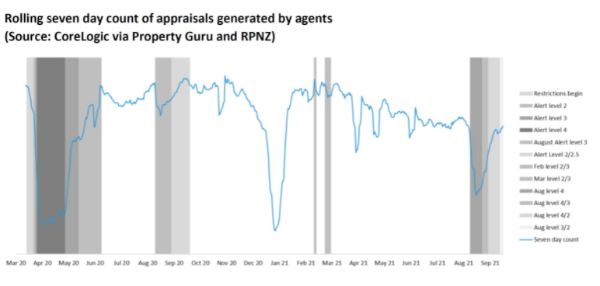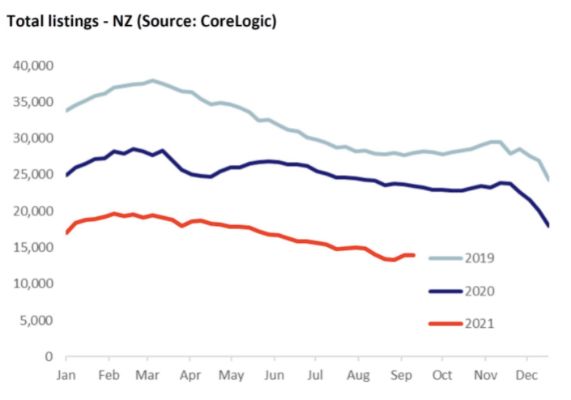Housing Market Momentum Continues To Wane
CoreLogic figures show property values increased nationally by 1.4% during September, a reduction on August’s monthly growth rate of 1.6% and the fifth consecutive month of easing growth rates, says Head of Research Nick Goodall.
With most of the country, aside from Auckland, at alert level 2 for the majority of September, market activity has started to return. However the three weeks at alert level 3 or above as well as movement restrictions in place during alert level 2 means the return has been gradual and subdued.
While this time around we were better prepared and experienced in how to carry on throughout lockdown, the limitation of movement and social interaction undoubtedly disrupts the property market temporarily.
We are now seeing agents back out there appraising properties to list them, and buyers are tentatively back in the market. We anticipate Auckland’s easing of restrictions will reinforce that trend.


Tracking of appraisals generated by agents using CoreLogic products Property Guru and RPNZ shows real estate agent activity has returned to a similar level recorded prior to the 18 August lockdown. Considering Auckland remains at the very restrictive alert level 3, this lift in appraisal numbers demonstrates a significant return to action from agents outside Aotearoa’s largest city.
This is encouraging news and indicates the potential for new listings, however the lockdown will continue to have a persistent dampening effect on overall stock levels, which are already at all-time low levels.
In the short term this lack of available supply may lead to some upward price pressure, especially when combined with pent up demand from people browsing listings portals through lockdown and evaluating their housing needs and wants.
However, this pressure is unlikely to linger too long, with market factors, including stretched affordability and changes in credit conditions such as tighter loan to value (LVR) controls and rising interest rates likely to impact the number of potential buyers in the market.
Investors are facing a much more regulated market and owner occupiers are about to have LVR restrictions further tightened (officially from 1 November) which will impact first home buyers the most.
Given affordability measures are already showing debt to income ratios at all-time highs, and with interest rates now on their way up, fewer people will be able to borrow the amount of money required to satisfy vendors’ expectations.
CoreLogic’s House Price Index (HPI) September results are relatively mixed across the country, providing yet another sign of increased diversity in the performance of the housing market where the pace of change in housing values is no longer in one direction across the sub-regions.
This is what can happen at turning points. Buyers ease back, but vendors won’t budge, so sales activity tends to decline without too much immediate impact on prices.
Property values in Rotorua rebounded (1.9%) in September after falling -0.9% in August, however the average value ($656k) in the Sulphur City is down -2.4% over the last three months. Meanwhile the monthly rate of growth in Gisborne dropped into the negatives (-0.7%) for the second time in four months, leaving the average value ($595k) up only 1.6% for the last quarter.
A noticeable bounce in performance in Queenstown (9.1% quarterly) has taken the average value to almost $1.5m ($1.49m). This rate of growth is the strongest since June 2016 and takes the annual increase to 30.4% – a $347,000 rise since 1 October 2020.
The quarterly rate of growth in Hastings has also accelerated, up 8.3%, taking the annual change to 41.4%, by far the largest rate of growth on record for the city (back to 1990).
Volatility is also evident across the main centres, too. Hamilton, which experienced a decrease in values in August, saw a significant reversal in that trend increasing 5.0% in September.
Dunedin values plateaued over the month (0.0% change) resulting in a 2.6% quarterly rate of growth which is the lowest of the main centres.
Meanwhile Tauranga is at the other end of the spectrum with values up 7.0% over the quarter and the annual growth rate hitting the highest level since March 2004 at 31.6%. The Wellington area’s annual rate of growth continued to break records, now 35.9%.
The variable results from the HPI may be reflective of an uncertain market, where unaffordability has led to reduced demand and subsequently less competition, but ‘quality stock’ is still fetching strong prices.
Increasing interest rates will play a part in reducing market activity and with the RBNZ lifting the official cash rate to 0.50%, demand is likely to further reduce.
Looking ahead, investors and owner occupiers alike will need to continue to prepare for higher mortgage repayments, and investors now need to adjust to the interest cost on mortgage repayments not being fully tax deductible. This is being phased out for properties bought prior to 27 March 2021 and there is no tax deductibility for existing properties bought after that date.
The outlook for property values is for growth to continue to slow through 2021 and into 2022. A key driver of this is increasing interest rates, but local factors will play a part to different degrees across the country. These factors include investor appeal, affordability constraints, the health of the local economy and borrowers’ debt management behaviour.


 NIWA: Students Representing New Zealand At The ‘Olympics Of Science Fairs’ Forging Pathway For International Recognition
NIWA: Students Representing New Zealand At The ‘Olympics Of Science Fairs’ Forging Pathway For International Recognition Coalition to End Big Dairy: Activists Protest NZ National Dairy Industry Awards Again
Coalition to End Big Dairy: Activists Protest NZ National Dairy Industry Awards Again Infoblox: Dancing With Scammers - The Telegram Tango Investigation
Infoblox: Dancing With Scammers - The Telegram Tango Investigation Consumer NZ: This Mother’s Day, Give The Gift Of Scam Protection And Digital Confidence
Consumer NZ: This Mother’s Day, Give The Gift Of Scam Protection And Digital Confidence NZ Airports Association: Airlines And Airports Back Visa Simplification
NZ Airports Association: Airlines And Airports Back Visa Simplification Netsafe: Statement From Netsafe About Proposed Social Media Ban
Netsafe: Statement From Netsafe About Proposed Social Media Ban